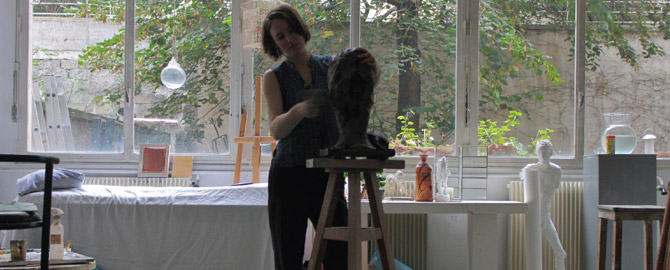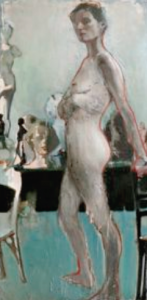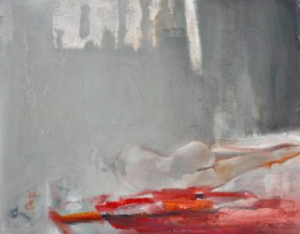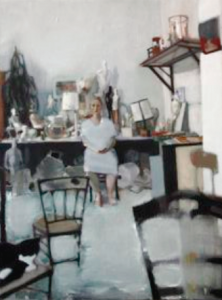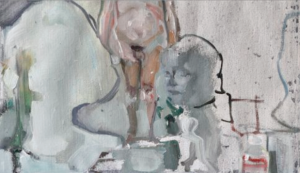I chose Lamb as Hong Kong Art Tutoring’s first Artist of the Week for a variety of reasons.
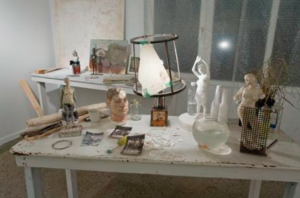
Sculpture composition as part of the exhibition "Outside the Garden", Galerie Pangée, Montréal, 2008
Firstly, I thought that it would be great to highlight a female Artist in a world that historically has been largely dominated by males. As a Fine Artist myself, I admit to having a certain bias towards other Fine Artists, however bias aside, Lambs’ work is a refreshing hybrid between drawing, sculpture and painting, where figurative traditional sculpture is fused with a contemporary approach and vision. Her work moves fluently and effortlessly between two and three dimension, in conjunction with using a diversity of media. She works on a variety of tactile surfaces that help generate the broken surfaces she creates. Lamb paints on linen or board, mixed media on plaster, painting with watercolour or drawing into the surfaces; she sculpts mostly in water clay then molds the clay and make the sculptures in plaster, bronze and occasionally resin and at the moment she is experimenting with casting in paper.
In Her own words
Why do you do what you do?
Why do I make stuff – I must confess it is not a question that I ask myself often and therefore not that natural for me to answer. I naturally gravitate toward making certain kinds of things and as I notice my own tendencies I feel more liberated to go after them –to become and create and reveal more of what pulls at me to be made. This process of observing outside and inside of myself is a way of harnessing interest and energy, a way of being and feeling alive and so I suppose why I do what I do is because I can’t help it.
How did you become an artist?
My mother and father are both artists and so is my maternal grandmother. My siblings and I were homeschooled for much of our childhood and our parents were always there with us, working on their creative projects, so we would also draw or write or read, or play the piano, or make homemade board games. “Being an artist” has always just seemed like a natural and enjoyable way to live and discover life, but also, given my parents, I wasn’t exactly aware that there was another option.
I always instill the importance of Drawing to my students, encouraging them to use Drawing as the foundation to their work. What disciplines or media do you find integral to the work of an artist and why?
For me, the process of drawing is very important, that is, not just making drawings, but the making of marks that correspond to what my eyes see is a starting point in most of my drawing, painting and sculpture. The more open I can be as I look and make marks the more I experience newness and can look beyond the scratchings of my familiar self.
Sometimes though, drawing has also felt like a trap. The feeling that I have to see and represent things just as they are or I have failed something or someone –that my corners of blindness are shameful. But when I look back at my work it is the paintings that I struggled with the most that I find the most interesting to look at – so my pain is a good subject it turns out.
I have just starting to work from my imagination a little bit more now, after years of feeling almost as if it would be wrong for me to paint anything entirely out of my head. I just finished the paintings for a book that I wrote called Paul meets Bernadette about the love between two gold fish (it will be out next year in the US, England and France). The exercise was quite liberating for me as all of a sudden I was painting my platonic ideal of objects rather than representing something I was looking at. It dawned on me that finding the balance between drawing from within and drawing from looking out, and allowing myself to flit between open seeing and my own subjective and faulty perception, is where works of art that I might make are hiding.
There are and have been many artists who hardly go in for life drawing at all and yet in their work it sometimes feels like a specific nature is revealed. Agnes Martin, Helen Frankenthaller, Richard Diebenkorn, Paul Klee, Howard Hodgkin are a few of my favorite artists who so beautifully and so sincerely draw from what is inside themselves.
What role does the artist have in society?
Some artists do succeed in having a very direct relationship with the society they live in but I do not. I am just here, hiding away to play a game that I love.
What work do you most enjoying doing, and why?
I most enjoy having several projects open in my studio and moving between them. Sometimes I will spend several days completely consumed with one painting or sculpture and at other times I will be making little alterations to everything in sight. I have never been able to have a super clean studio with just one piece that I am working on. Everything sort of informs and inspires everything else and by the end of every day the work I have done changes what I thought my direction was that morning.
Rosy Lamb born July 23, 1973 in Tamworth, New Hampshire is an expatriate American sculptor living in Paris, France. She graduated from the Pennsylvania Academy of the Fine Arts and became the assistante d’atelier of Jean Cardot, a prominent French sculptor, before her work gained attention in its own right.
All images courtesy of Rosy Lamb
For more information on Hong Kong Art Tutoring please contact Gail Deayton
Telephone: +852 9722 8353
Email: gd@gaildeayton.com
www.hkarttutoring.com

